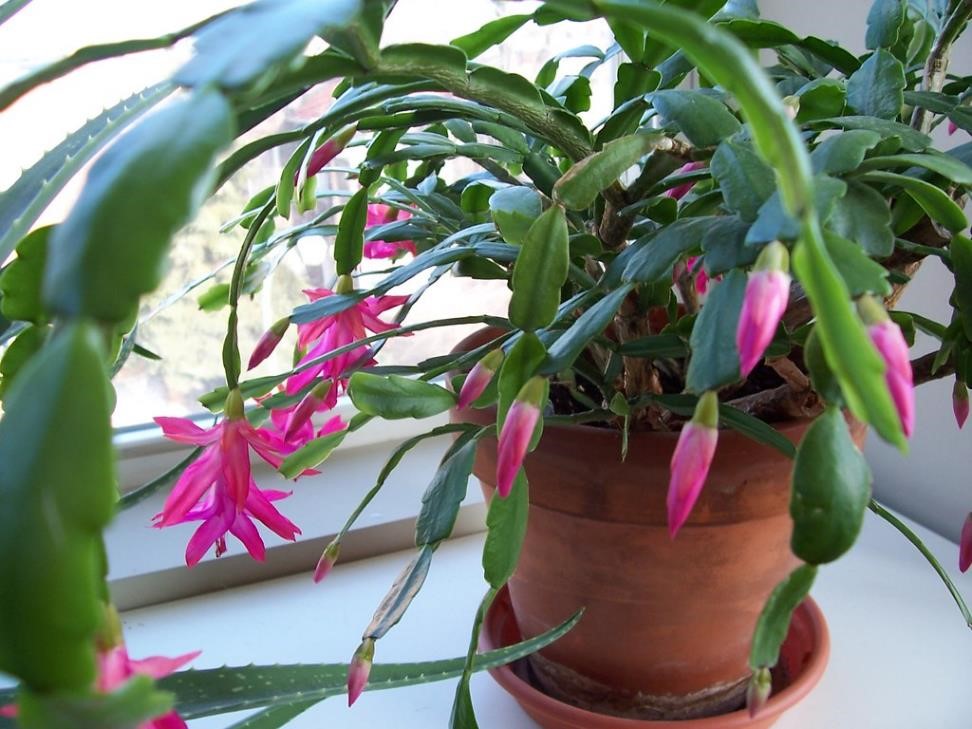Southwest Yard & Garden – Christmas Cactus Care

Beautiful blossoms aside, notice how smooth the edges of the flattened leaves are on this Christmas cactus. Photo credit spablab flickr.com.
Question: How should I care for my new Christmas cactus to ensure long-term health and rebloom next year?
- Wendy H., Las Cruces, NM
Answer: Christmas cactus (Schlumbergera bridgesii), a hybrid plant and member of the cactus family, is known for blooming during the holiday season here in the northern hemisphere. The showy flowers are induced by long periods of uninterrupted dark. If your plant routinely blooms early, you may have a different species, Thanksgiving cactus (Schlumbergera truncata), which has different requirements for the number of dark hours and therefore blooms at a slightly different time. Thanksgiving cactus has stem segments with more pronounced indentations (aka teeth) and is also called “crab cactus.” Easter cactus is a different genus altogether (Schlumbergera gaertneri) and has even smoother, scalloped stem edges than Christmas cacti. It turns out all three in my home are the Thanksgiving kind.

Like clockwork, this Thanksgiving cactus with purple stems, was in full bloom when I took this photo on November 25, 2020. Photo credit Marisa Thompson.

Teeth on the flattened stem segments of this cactus are a hint that it is a Thanksgiving cactus instead of the smoother edges found on Christmas cacti, but this plant is so beautiful I’ll call it whatever it wants. Photo credit WikiCommons.
There are a few key things you can do to encourage a longer blooming period and return bloom next year. I mined archived columns for the best tips:
Let the soil dry slightly between waterings. Surplus water should drain away, leaving the soil about as moist as a wrung-out sponge.
Avoid drafty locations near open doors and heater vents. These locations speed the drying of the soil and plants. Keep the plants in a cool location. Cool air slows the aging of the flowers, so they last longer, but do not let the temperature drop below 50°F. Temperature-wise, they are not as fussy as some other seasonal houseplants, such as poinsettia (check in next week for poinsettia dos and don’ts).
Maintain these plants in a brightly lit location. If there is sufficient light, the plants can photosynthesize and manufacture food to sustain the plant and flowers.
Do not apply fertilizer during flowering. Wait until spring, when new growth appears, to fertilize and replant.
Once buds set, don’t move the plant around too much. Flower buds are likely to drop off if the plant is moved or suddenly exposed to temperature changes.
In the spring when the plant is actively growing, you can prune your cactus by cutting between stem segments using clean, sharp shears that do not tear the plant tissue. Flower buds develop at the distal edges (ends) of each stem, so by pruning, you are encouraging branching and therefore maximizing flower potential next season. Those cuttings can be easily propagated by letting stems of 2–3 segments in length dry for a day so the wound callouses over and then replanting them in new soil, taking care not to place stems upside down in the new soil.
Next fall, be sure to keep your Christmas cactus in a spot where it gets a full dose of dark time (10–12 hours per day) so that flowering is induced all over again.
Retired NMSU Extension Horticulture Specialist, Dr. Curtis Smith, says, “I have always found that people are surprised to learn that Christmas cacti are tropical epiphytes. In their native habitat, they grow on trees rather than in the soil to get above enough foliage to get enough light. They can also be lithophytes, growing in cracks and crevices in rocks and cliffs. In both locations, their growing medium is decomposing organic matter—compost. In these environments, it dries rapidly, but in the rainforest there are frequent rains. In pots, we have to be careful not to overwater them, and as cacti they can tolerate significantly more drying than other plants.”
When buying new plants, I select Christmas cactus specimens with plenty of closed buds because I like the bright surprise of new blooms and I want the color to last as long as possible at home. You can estimate maturity of individual flowers by examining the petals. Wrinkly petal margins and fine pollen dust mean the flower will not last much longer before it droops and falls from the plant.
Post photos of your happy/blooming/not-blooming/struggling Christmas cactus on social media and tag me @NMDesertBlooms. Photos of Thanksgiving cactus, Easter cactus, and our native Christmas cactus (Cylindropuntia leptocaulis) are also welcome!
Email me your gardening questions at desertblooms@nmsu.edu.
For more gardening information, visit the NMSU Extension Horticulture page at Desert Blooms (http://desertblooms.nmsu.edu/) and the NMSU Horticulture Publications page at http://aces.nmsu.edu/pubs/_h/.
Marisa Y. Thompson, PhD, is the Extension Horticulture Specialist, in the Department of Extension Plant Sciences at the New Mexico State University Los Lunas Agricultural Science Center, office: 505- 865-7340, ext. 113.
